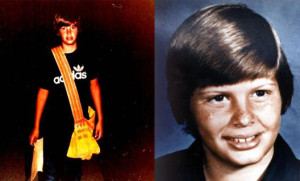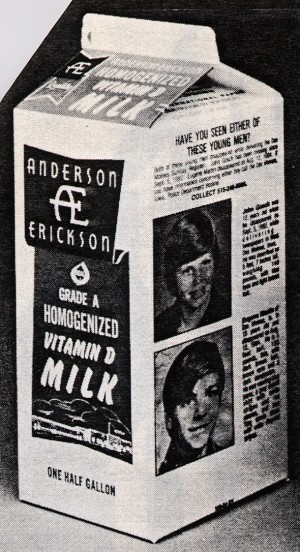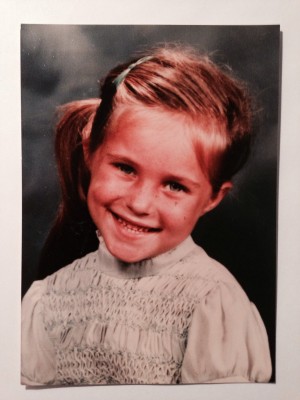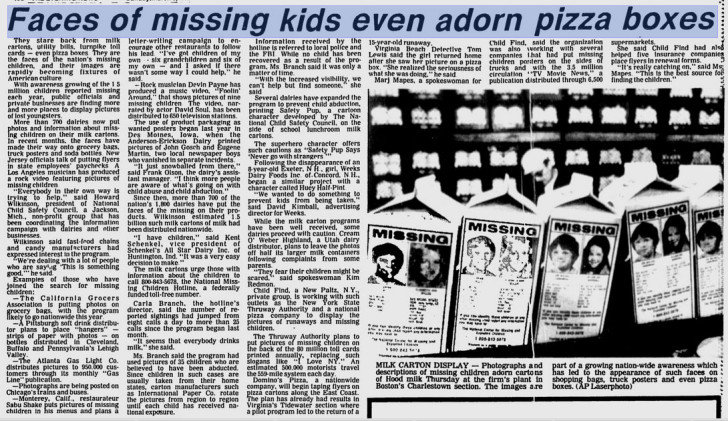On a Sunday morning in 1982, in Des Moines, Iowa, Johnny Gosch left his house to begin his usual paper route. A short time later, his parents were awakened by a phone call–it was a neighbor—their paper hadn’t come. When the Gosches went looking for Johnny they found only his red wagon full of newspapers, abandoned on the sidewalk.
Johnny Gosch was 13 when he disappeared. He had blue eyes and dirty blond hair with a small gap between his front teeth. And his would be the first face of a missing child ever printed on a milk carton.

Johnny’s face wouldn’t find its way onto a milk carton right away though. In September of 1982, when he disappeared, the milk carton program didn’t exist yet, and in fact, Johnny’s parents struggled to get the authorities to take their son’s case seriously. Police were skeptical that he had really been abducted. This sort of thing was just not supposed to happen in wholesome towns in Middle America.
At the time of Johnny’s disappearance there was no legal distinction between a missing child and a missing adult. As such, Johnny’s parents had to wait three days before authorities would consider him a “missing person.” While the Gosches continued to search for their son, Noreen Gosch helped write legislation that would distinguish children from adults in missing persons cases in the state of Iowa.

And then, two years after Johnny, another paperboy named Eugene Martin went missing from a nearby neighborhood. This time a relative working at Anderson & Erickson Dairy got his employer to help. The result was a local milk carton campaign featuring the images of Eugene and Johnny. Within weeks, cartons with images of the two kids were all over the city.
Other area dairies got on board and the endeavor quickly went national, spreading to 700 independent dairies coordinated in part by the National Child Safety Council.
On larger cartons destined for home refrigerators, two children were put side by side. On smaller ones, such as those found in school lunches, a single child would be featured. The children depicted were generally selected from a pool of those presumed to have been abducted by strangers.

As many as 5 billion milk cartons were printed with the images and details of missing children from around the country. But despite the impressive circulation of these images, very few direct successes were tied to either local or national campaigns. Most of the children featured on milk cartons were never found, including Johnny Gosch and Eugene Martin. One child in particular was a compelling exception—a little girl who one day came face to face with her own image on a carton in the supermarket.
Taken from her father by her mother and stepfather (rather than a stranger), Bonnie Lohman was not a typical candidate for a milk carton. Still, her father managed to get her included.
Abducted at the age of 3, Bonnie grew up living in places like Saipan and Hawaii, frequently dwelling in shacks and rarely allowed outdoors. She was slowly given more freedom as the years passed. One exceptional day, after moving to Colorado, she went with her stepfather to the grocery store for milk, where at age 7 she came face to face with her image on a carton.

Bonnie could not read and did not know the box had the words MISSING CHILD across the top. It might have ended there it were not for the hubris of one of her abductors. Her stepfather not only bought that carton of milk but he also cut out the image and allowed her to save it.
Though she was warned by her stepdad to keep the milk carton image a secret, Bonnie accidentally left it (inside a box of her toys) at the house next door. Police were called and Bonnie was reunited with her father.
Bonnie’s story was a rare win in a campaign that was largely unsuccessful at locating missing children. The milk cartons were successful however, at sparking social and political change. They raised awareness and contributed to legislative efforts including the Missing Children Assistance Act.

As the carton campaign wound down, it also gave way to a series of related campaigns on pizza boxes, utility bills and grocery bags.

Still, none of these quite struck a nerve like the faces of missing children featured on milk cartons, an inevitable source of conversation for families sitting down at the table together to share a meal.




Comments (27)
Share
Those milk cartons inspired important conversations and other programs on ‘stranger danger’. 3 times I was almost abducted. 3 times! The ‘penny’ trick, the ‘puppy’ trick, and the ‘I know your mom.’ trick were all attempted. Thanks to school stranger danger programs I was able to see these attempts as scams and avoided abduction. I am grateful.
Hi, according to this, Etan Patz was the first milk carton child. https://en.m.wikipedia.org/wiki/Etan_Patz
In this case, Wikipedia is not correct (nor the sources it cites). Patz may have been the first child in a national campaign but not local/regional.
Are Mazlo and Carver covering Minor Threat at the end? Are we friends that just haven’t met yet?
I love the podcast, keep up the great work, maybe I’ll see you next time I’m on Oakland.
What song?
Close. Minor Threat adjacent–The Teen Idles. Punk’s not dead, it just goes to bed early.
Check out http://swordandscale.com/sword-and-scale-episode-5/
a podcast about truecrime for very indepth details on this kidnapping case about Johnny.
You told us that the campaign lasted only two years four full times. Edit.
This story seemed one sided, offering comment only from those involved with the milk carton campaign. An important point was omitted: Did these photos cause kidnappers more quickly and more frequently to kill and dispose of these abducted children before they could be spotted. With these milk carton photos in circulation, the child was an obvious liability to the perpetrator. This might be a big part of why so few milk carton kids were ever recovered.
I was personally acquainted with a kid who ended up on a milk carton. It turned out that he had been killed years before, tragically, so the carton was irrelevant. But since most kidnapping cases involve noncustodial parents, and perpetrators who intend to kill don’t wait around, it seems unlikely that the pictures ever prompted murder.
The “Gosches”, not “Goschs”
thanks! fixed it.
“…a fictional novel by Caroline B. Cooney” means that the novel didn’t exist, like “a fictional character.” Novels are by definition fiction, so “fictional novel” is a confusing tautology.
It’s a fascinating article, though, and it’s tragic to hear that the police wouldn’t begin to investigate a missing child for three days.
Fixed!
The song at 8:50 is neither of the two listed on the track notes.
What is it please?
There is an old-school arcade I go to that still has a photo of a missing kid flash on the screen about every minute. I have no idea how long it has been on that machine.
Omg I read the book the face on the milk carton. And I thought it was all fake but now I know that it is real!
Anybody who is readin this, the face on the milk carton is really good y’all should read it.
Okay, here’s the deep irony of the milk carton missing-children campaign:
The dairy industry is predicated on the separation of mother and child.
In order for a cow to give milk, she must, of course–like humans and other mammals–have a child. But in order for humans to use that milk to fill cartons, her child must be taken from her. (The boys are sold to veal farms unless the dairy has its own veal wing, and the girls are isolated until puberty and then are made to milk as well. They are fed a cheap artificial milk-replacer.)
It was fascinating to hear someone in this piece talk about cow’s milk as a symbol of nurturing. For a calf, of course it is; it is perfectly designed for that particular mammal’s survival and thriving. But for a cow’s udder to be connected to a machine and a carton–well, it’s the opposite of nurturing.
Mammals are very hard to raise, so evolutionary biology has filled new mothers and babies–cows and humans alike–with specific hormones to build a profound bond. There is a great deal of footage of people pulling calves away from their mothers, and the footage is harrowing. Cows and calves call for each other for days.
So, in this context, it does seem laughable for this particular industry to stake a claim to connecting mothers and children.
very thought-provoking comment.
They still have faces of missing people on some bottles of milk in the UK; Co-op I think.
This was an interesting episode, but I wish you’d talked about how infrequently children are abducted by strangers. Something like 75% of children are abducted by relatives and acquaintances (majority of kidnappers are noncustodial parents). The milk carton campaign inaccurately inflated the idea of “stranger danger”; maybe that’s why the campaign wasn’t very successful. http://www.parents.com/kids/safety/stranger-safety/child-abduction-facts/
Should have listened until the end of the episode- thanks for addressing the issue of noncustodial parents kidnapping children.
While the cartons resulted in very few found children, there is no doubt in my mine they prevented many abductions by creating conversations between parents and kids. Having been born in 1980 I vividly remember these and talks and dinner regarding the abductions.
More Boards of Canada, eh? At one minute in, that’s “The Devil is in the Details” – Boards of Canada, album Geogaddi.
I’m kind of blown away by how few kids were found as a result of this, given how many people drink milk…contrast this with that Soul Asylum video, they found quite a few through that video as I recall. (In addition, I remember seeing some kind of mini-documentary about it a while back, where apparently a couple of the kids that were found as a result of that video were super angry at the band and the people responsible for putting their faces in the video, as some of them were returned to people that continued to abuse them, which was why they ran away to begin with.)
I’m listening to a Stuff You Should Know piece claiming Bonnie Lohman never existed. Can you address this?
If you grew up in the 1980s, you thought you had a 50%
* duration: 54:38, Played: 27:56
* Published: 7/20/21 5:00:00 AM
* Episode Download link (38 MB): https://www.podtrac.com/pts/redirect.mp3/pdst.fm/e/chtbl.com/track/5899E/traffic.megaphone.fm/HSW3653342217.mp3?updated=1626728912
* Episode feed: Stuff You Should Know – https://feeds.megaphone.fm/stuffyoushouldknow